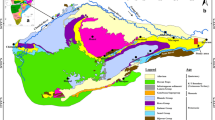Summary and Conclusions
In this paper, the results of field and laboratory study on the geology, petrochemistry, petrogenesis and economics of the Pachipenta Zamindari have been presented.
A succession of the various members of the khondalite series has been given. Based on petrochemical evidence, the biotite gneiss is considered to represent a metamorphosed argillaceous sandstone. The parent rock of the garnetiferous gneiss is considered to be an argillaceous sediment somewhat poor in alumina. The diopside quartzite has been considered to be the metamorphosed representative of a dolomitic sandstone. Petrographic descriptions of the other members of the khondalite series have been given,
Petrochemical study of the charnockites has also been made and the striking resemblance of the augite norites of the area to the norites of Bushveld has been pointed out as also its general affinities with the calcalkaline suite of igneous rocks. An igneous intrusive origin has been attributed to these rocks. A brief description of the economics of the area has also been given.
Similar content being viewed by others
Bibliography
Benza, P. M. “Notes chiefly geological of a journey through the Northern Circars in the year 1835,”Mad. Jour. Lit. Sci., 1897,5.
CarmichaelA Manual of Vizagapatam District, 1869.
Crookshank, H. “The Western Margin of the Fastern Ghats,”Rec. G.S.I., 1938,43, 398–424.
Fermor, L. L. “An attempt at the correlation of the Ancient Schistose formations of Peninsular India,”Mem. G.S.I., 1935,70, Parts 1 and 2.
Hess, H. H., and Phillips, F. H. “Orthopyroxenes of the Bushveld type,”Amer. Min., 1938,23, 400–56.
Holland, T. H. “The Charnockite series, a group of Archæan Hypersthenic rocks in Peninsular India,”Mem. G.S.I., 1900,28, Part 2.
Johannsen, A.A Descriptive Petrography of Igneous Rocks, 1939.
King, W. “Geological Sketch of the Vizagapatam Dist.,”Rec. G.S.I., 1886,19, Part 3.
Lacroix “Gneissose Rocks of Salem,”ibid.,, 1891,24, Part 3, 155–200.
Mahadevan, C. “Geology of the Vizagapatam Harbour area,”Quart. Journ. Geol. Min. Met. Soc. Ind., 1929,2, No. 4.
Mahadevan, C., and Gopalakrishna Sastry, G. Optically Positive Cordierite from the Khondalites of Pachipenta,Proc. Ind. Acad. Sci., 1948, A,27, 361–365.
Middlemiss, C. S. “Note on a sapphirine bearing rock from Vizagapatam Dist.,”Rec. G.S.I., 1904,31, Part 1, 38–42.
Rama Rao, B. “The Charnockite Rocks of Mysore,”M.G.D. Bull., 1945, 18.
Sen Gupta, K. K. “On the Hypersthenisation of Monoclinic Pyroxene (in Charnockite),”Jour. As. Soc. Beng., 1916, N.S.12.
Smith, F. H. “Preliminary Report of the Geology of Ganjam Dist.,”G.S.I. Gen. Rep., 1899–1900, 1900, cxxi.
Walker, T. L. “The Geology of the Kalahandi State,”Mem. G.S.I., 1902,33, Part 3. Walker, T. L. and Collins, W. H. “Petrological study of some rocks from the Hill tracts, Vizagapatam Dist.,”Rec. G.S.I., 1907,36, 1–18.
Washington, H. S. “The Charnockite series of Igneous rocks,”Amer. Jour. of Sci., 1916,41, Art. XXII, 323.
Winchell, A. N.Elements of Optical Mineralogy, 1927.
Additional information
(Communicated by Prof. C. Mahadevan,p.a.sc.)
Rights and permissions
About this article
Cite this article
Sastri, G.G. Geology and petrology of pachipenta Zamindari, Vizagapatam District, Madras presidency. Proc. Indian Acad. Sci. (Math. Sci.) 29, 35 (1949). https://doi.org/10.1007/BF03172437
Received:
DOI: https://doi.org/10.1007/BF03172437




